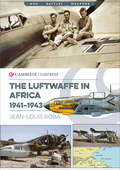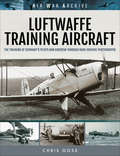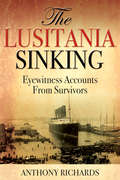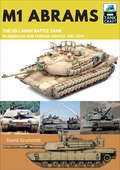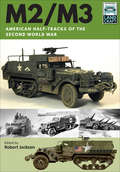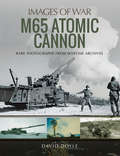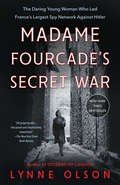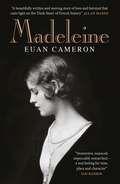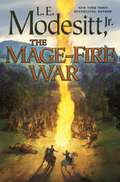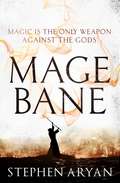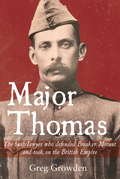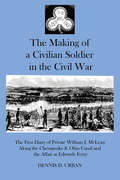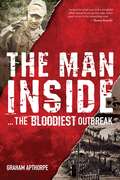- Table View
- List View
The Lost Shtetl: A Novel
by Max GrossWINNER OF THE NATIONAL JEWISH BOOK AWARD AND THE JEWISH FICTION AWARD FROM THE ASSOCIATION OF JEWISH LIBRARIESGOOD MORNING AMERICA MUST READ NEW BOOKS * NEW YORK POST BUZZ BOOKS * THE MILLIONS MOST ANTICIPATEDA remarkable debut novel—written with the fearless imagination of Michael Chabon and the piercing humor of Gary Shteyngart—about a small Jewish village in the Polish forest that is so secluded no one knows it exists . . . until now.What if there was a town that history missed?For decades, the tiny Jewish shtetl of Kreskol existed in happy isolation, virtually untouched and unchanged. Spared by the Holocaust and the Cold War, its residents enjoyed remarkable peace. It missed out on cars, and electricity, and the internet, and indoor plumbing. But when a marriage dispute spins out of control, the whole town comes crashing into the twenty-first century.Pesha Lindauer, who has just suffered an ugly, acrimonious divorce, suddenly disappears. A day later, her husband goes after her, setting off a panic among the town elders. They send a woefully unprepared outcast named Yankel Lewinkopf out into the wider world to alert the Polish authorities. Venturing beyond the remote safety of Kreskol, Yankel is confronted by the beauty and the ravages of the modern-day outside world – and his reception is met with a confusing mix of disbelief, condescension, and unexpected kindness. When the truth eventually surfaces, his story and the existence of Kreskol make headlines nationwide. Returning Yankel to Kreskol, the Polish government plans to reintegrate the town that time forgot. Yet in doing so, the devious origins of its disappearance come to the light. And what has become of the mystery of Pesha and her former husband? Divided between those embracing change and those clinging to its old world ways, the people of Kreskol will have to find a way to come together . . . or risk their village disappearing for good.
Lovely War
by Julie BerryA sweeping, multi-layered romance set in the perilous days of World Wars I and II, where gods hold the fates--and the hearts--of four mortals in their hands. <P><P>They are Hazel, James, Aubrey, and Colette. A classical pianist from London, a British would-be architect-turned-soldier, a Harlem-born ragtime genius in the U.S. Army, and a Belgian orphan with a gorgeous voice and a devastating past. Their story, as told by goddess Aphrodite, who must spin the tale or face judgment on Mount Olympus, is filled with hope and heartbreak, prejudice and passion, and reveals that, though War is a formidable force, it's no match for the transcendent power of Love. <P><P>Author Julie Berry's critically-acclaimed writing has been called "haunting and unforgettable" by New York Times bestselling author of Salt to the Sea Ruta Sepetys and "utterly original and instantly engrossing" by Publishers Weekly.
Luftwaffe in Africa, 1941–1943 (Casemate Illustrated #Cis0015)
by Jean-Louis RobaThis WWII history examines Nazi air force operations in Egypt and Libya with more than 100 rare wartime photographs. When Mussolini&’s army was defeated on the Libyan-Egyptian border at the beginning of 1941, Adolph Hitler had no choice but to send reinforcements to help his ally. The Luftwaffe deployed an air detachment, first to Sicily, then to North Africa. This volume examines the small expeditionary force, solely devoted to protecting Italian possessions in the Mediterranean and Middle Eastern theater. When General Erwin Rommel launched his Afrika Korps to the east, the Luftwaffe had to go on the offensive to cover the advance. As British air forces were strengthened, German High Command was obliged to send more aerial units into what it had initially considered a peripheral arena of the war. Losses in bombers and fighters were high on both sides. By the time the Allies landed in Morocco and Algeria at the end of 1942, the Wehrmacht&’s fate was sealed. The last German units capitulated in Tunisia in May 1943.
Luftwaffe Training Aircraft: The Training of Germany's Pilots and Aircrew Through Rare Archive Photographs (Air War Archive)
by Chris GossFrom a retired RAF Wing Commander, an introductory guide to the aerial warfare training methods implemented by Germany for airmen during World War II. The often-unnoticed element in aerial warfare is the training, yet its value is beyond calculation. The Luftwaffe used a variety of aircraft in this fundamental role, with trainee pilots progressing from simpler, older machines to the more sophisticated, as well as heavier aircraft. Gradually airmen were introduced to newer, faster models that enabled them to experience, to some degree, the type of aircraft they would fly in combat. Recruits would initially spend six months at a Fliegerersatzabteilung or training depot, where the main emphasis was on drill and physical training, with introductory lectures on the principles of wireless operation and map reading. This would be followed by two months studying general aeronautical subjects, before being sent to elementary flying school. The various kinds of aircraft used for training depended upon the role each individual trainee would eventually undertake, from single-seat fighters to multiple-crew bombers or transports. In this, the Luftwaffe was also able to make use of captured enemy aircraft. It also established training units through the Occupied territories to enable its trainees to familiarize themselves with different conditions and terrain. In the less-pressurized environment of the training schools away from the front line, more care could be taken over photography, resulting in the author of this extensive study of the wide range of aircraft used for training by the Luftwaffe, being able to assemble such a fine collection of excellent images.
The Lunatic Merciful person: Volume 1 (Volume 1 #1)
by Yu QingmuThe Central Plains was built side by side with the Hundred Kingdoms.The powers of each nation were about the same, but after the fall of the only empire in the country, the Empire of Chu and Tang, they waged a full-scale war for the throne.The flames of war swirled around him as his spirit was burnt to ashes.Good to evil, reincarnation limitless, willing to be a Qinglian one-man, do not be the world's worst.The four images were all empty, and they were all based on kindness.
The Lunatic Merciful person: Volume 2 (Volume 2 #2)
by Yu QingmuThe Central Plains was built side by side with the Hundred Kingdoms.The powers of each nation were about the same, but after the fall of the only empire in the country, the Empire of Chu and Tang, they waged a full-scale war for the throne.The flames of war swirled around him as his spirit was burnt to ashes.Good to evil, reincarnation limitless, willing to be a Qinglian one-man, do not be the world's worst.The four images were all empty, and they were all based on kindness.
The Lunatic Merciful person: Volume 3 (Volume 3 #3)
by Yu QingmuThe Central Plains was built side by side with the Hundred Kingdoms.The powers of each nation were about the same, but after the fall of the only empire in the country, the Empire of Chu and Tang, they waged a full-scale war for the throne.The flames of war swirled around him as his spirit was burnt to ashes.Good to evil, reincarnation limitless, willing to be a Qinglian one-man, do not be the world's worst.The four images were all empty, and they were all based on kindness.
The Lunatic Merciful person: Volume 7 (Volume 7 #7)
by Yu QingmuThe Central Plains was built side by side with the Hundred Kingdoms.The powers of each nation were about the same, but after the fall of the only empire in the country, the Empire of Chu and Tang, they waged a full-scale war for the throne.The flames of war swirled around him as his spirit was burnt to ashes.Good to evil, reincarnation limitless, willing to be a Qinglian one-man, do not be the world's worst.The four images were all empty, and they were all based on kindness.
The Lunatic Merciful person: Volume 5 (Volume 5 #5)
by Yu QingmuThe Central Plains was built side by side with the Hundred Kingdoms.The powers of each nation were about the same, but after the fall of the only empire in the country, the Empire of Chu and Tang, they waged a full-scale war for the throne.The flames of war swirled around him as his spirit was burnt to ashes.Good to evil, reincarnation limitless, willing to be a Qinglian one-man, do not be the world's worst.The four images were all empty, and they were all based on kindness.
The Lunatic Merciful person: Volume 6 (Volume 6 #6)
by Yu QingmuThe Central Plains was built side by side with the Hundred Kingdoms.The powers of each nation were about the same, but after the fall of the only empire in the country, the Empire of Chu and Tang, they waged a full-scale war for the throne.The flames of war swirled around him as his spirit was burnt to ashes.Good to evil, reincarnation limitless, willing to be a Qinglian one-man, do not be the world's worst.The four images were all empty, and they were all based on kindness.
The Lunatic Merciful person: Volume 4 (Volume 4 #4)
by Yu QingmuThe Central Plains was built side by side with the Hundred Kingdoms.The powers of each nation were about the same, but after the fall of the only empire in the country, the Empire of Chu and Tang, they waged a full-scale war for the throne.The flames of war swirled around him as his spirit was burnt to ashes.Good to evil, reincarnation limitless, willing to be a Qinglian one-man, do not be the world's worst.The four images were all empty, and they were all based on kindness.
The Lusitania Sinking: Eyewitness Accounts from Survivors
by Anthony RichardsUncertain of their son's fate, his family leaped into action. The sinking of the passenger liner Lusitania was a maritime disaster that may have changed the course of history by making American involvement in World War I almost inevitable. This part of the story has been told before but here, for the first time, The Lusitania Sinking has a far more personal tale to tell, of a family looking for information on their son's death. On 1 May 1915 Preston Prichard, a 29-year-old student, embarked as a second-class passenger on the Lusitania, bound from New York for Liverpool. Just after 2 p.m. on 7 May, a single torpedo, fired by the German submarine U-20, caused a massive explosion in the Lusitania's hold, and the ship began sinking rapidly. Within 20 minutes she disappeared and 1,198 men, women and children, including Preston, died. Preston's mother wrote hundreds of letters to survivors to find out more about what might have happened in his last moments. The replies she received included an extensive selection of moving and evocative survivors' accounts. Although this was not Mrs Prichard's intention, she thus assembled an outstanding collection of vivid first-hand recollections. The Lusitania Sinking tells the story of this tragedy using this previously unseen historical treasure trove.
M1 Abrams: The US's Main Battle Tank in American and Foreign Service, 1981–2019 (Tank Craft)
by David GrummittA history of the iconic vehicle: &“This modeler's delight showcases the M1 and its variations with all sorts of camouflage schemes.&” —Historical Miniatures Gaming Society Since its introduction in 1981, at the height of the Cold War, the Abrams main battle tank has been one of the most visible symbols of American military power, and it is the fascinating subject of this heavily illustrated historical and modeling guide in the TankCraft series by David Grummitt. Designed to meet head-on the massed tank forces of the Warsaw Pact, its combat debut actually came in a different scenario in 1991, during the First Gulf War. Since then it has served in a peacekeeping role in the former Yugoslavia and seen combat in Iraq, Afghanistan, and Yemen. It has gone through a series of modifications and modernizations that see it set to remain the backbone of the US Army until at least 2050. As well as charting the development and combat history of the vehicle, this book is illustrated throughout with color photos and specially commissioned color profiles. Five different models, covering the service history of the Abrams, are featured, as is a modeler&’s guide to the existing kits and accessories in the all the popular scales.
M1 Abrams: Rare Photographs From Wartime Archives (Images of War)
by David DoyleA photographic history of the principal main battle tank of the modern US military. Conceived to counter the threat of a massive Soviet armored incursion in Europe, the M1 Abrams tank gained considerable fame during the Persian Gulf War of 1991, and its combat record has continued to climb. With such a long service life, the Abrams has undergone continual improvements and upgrades, which are illustrated in great detail in this volume. The unique features of the various models are detailed in stunning color photos, and the combat use of these fearsome vehicles is richly illustrated through previously unpublished photos. The story of the Abrams begins in the late 1960s when the threat of Soviet Armor developments forced the U.S. to look for a suitable replacement for the M60 series. A joint venture between the U.S. and West Germany to build a suitable common Main Battle Tank brought about the unorthodox and terribly expensive MBT70. It never saw series production. When this program was cancelled in 1970, a quest for a more cost-effective tank was begun. The constant development, upgrade, and conversion of the series have kept the Abrams at the forefront of main battle tank technology—and it has proven itself on the battlefield time and time again. This book, filled with rare archival photos, takes us through decades of its remarkable history, including improvements to its armor, transmission, and engine; the addition of an integrated nuclear, biological, and chemical system; the installation of a layer of depleted uranium and interior blast doors to protect the crew, and more.
M1 Abrams: The US's Main Battle Tank in American and Foreign Service, 1981–2019 (Tank Craft)
by David GrummittA history of the iconic vehicle: &“This modeler's delight showcases the M1 and its variations with all sorts of camouflage schemes.&” —Historical Miniatures Gaming Society Since its introduction in 1981, at the height of the Cold War, the Abrams main battle tank has been one of the most visible symbols of American military power, and it is the fascinating subject of this heavily illustrated historical and modeling guide in the TankCraft series by David Grummitt. Designed to meet head-on the massed tank forces of the Warsaw Pact, its combat debut actually came in a different scenario in 1991, during the First Gulf War. Since then it has served in a peacekeeping role in the former Yugoslavia and seen combat in Iraq, Afghanistan, and Yemen. It has gone through a series of modifications and modernizations that see it set to remain the backbone of the US Army until at least 2050. As well as charting the development and combat history of the vehicle, this book is illustrated throughout with color photos and specially commissioned color profiles. Five different models, covering the service history of the Abrams, are featured, as is a modeler&’s guide to the existing kits and accessories in the all the popular scales.
M2/M3: American Half-tracks of the Second World War (LandCraft #2)
by Robert JacksonA history of these versatile vehicles, with photos and useful information for modelers. Among the most successful armored vehicles produced by American industry—known as the Arsenal of Democracy—during the Second World War were the M2 and M3 half-tracks. They served on every battlefront and were as recognizable as other famous American wartime vehicles like the Sherman and the Jeep, and around 40,000 were produced between 1941 and 1945. They were easy to assemble, operate and maintain, and their versatility allowed them to fulfill a variety of purposes. This volume traces the design, development, and manufacturing history of the M2/M3 and describes its operational role within the Allied armies. A selection of archive photographs showing the M2/M3 in action gives a graphic impression of how adaptable these vehicles were and records the range of equipment they could carry. The book is also an excellent source for the modeler, providing details of available kits, together with specially commissioned color profiles demonstrating how the M2/M3 used by different units and armies appeared.
M65 Atomic Cannon: Rare Photographs From Wartime Archives (Images of War)
by David DoyleA pictorial history of this powerful piece of artillery, an icon of the Cold War era. In 1949, the US Army wanted an artillery gun that could fire a nuclear warhead in the event that guided missiles and long-range bombers proved insufficient in delivering atomic weapons. The result was the M65 280mm Atomic Cannon. On May 25, 1953, at 0830 hours, an M65 of A Battery, 867th Field Artillery Battalion, let loose with the only nuclear round the type would ever fire. Six battalions of the M65 would eventually be deployed, most in Europe with one battalion sent to the Korean Peninsula. Though never used in combat, they served as a significant tactical nuclear deterrent. Through historic photos, this volume traces the development, production and deployment of this iconic piece of military equipment from the drawing boards to the Cold War battlefields of Europe.
Madame Fourcade's Secret War: The Daring Young Woman Who Led France's Largest Spy Network Against Hitler
by Lynne OlsonThe little-known true story of Marie-Madeleine Fourcade, the woman who headed the largest spy network in occupied France during World War II, from the bestselling author of Citizens of London and Last Hope Island <P><P> In 1941 a thirty-one-year-old Frenchwoman, a young mother born to privilege and known for her beauty and glamour, became the leader of a vast intelligence organization—the only woman to serve as a chef de résistance during the war. <P><P>Strong-willed, independent, and a lifelong rebel against her country’s conservative, patriarchal society, Marie-Madeleine Fourcade was temperamentally made for the job. Her group’s name was Alliance, but the Gestapo dubbed it Noah’s Ark because its agents used the names of animals as their aliases. The name Marie-Madeleine chose for herself was Hedgehog: a tough little animal, unthreatening in appearance, that, as a colleague of hers put it, “even a lion would hesitate to bite.” <P><P>No other French spy network lasted as long or supplied as much crucial intelligence—including providing American and British military commanders with a 55-foot-long map of the beaches and roads on which the Allies would land on D-Day—as Alliance. <P><P>The Gestapo pursued them relentlessly, capturing, torturing, and executing hundreds of its three thousand agents, including Fourcade’s own lover and many of her key spies. <P><P>Although Fourcade, the mother of two young children, moved her headquarters every few weeks, constantly changing her hair color, clothing, and identity, she was captured twice by the Nazis. <P><P>Both times she managed to escape—once by slipping naked through the bars of her jail cell—and continued to hold her network together even as it repeatedly threatened to crumble around her. <P><P>Now, in this dramatic account of the war that split France in two and forced its people to live side by side with their hated German occupiers, Lynne Olson tells the fascinating story of a woman who stood up for her nation, her fellow citizens, and herself. <P><b>A New York Times Bestseller</b>
Madeleine
by Euan Cameron"Immersive, nuanced, impeccably researched" IAN RANKIN"Beautifully written and moving" ALLAN MASSIE"Poignant, nostalgic and redolent of the smell of France" SIMON BRETTFamily history has always been a mystery to Will Latymer. His father flatly refused to talk about it, and with no other relatives to consult, it seems that a mystery it shall always remain. Until of course, Will meets Ghislaine, his beautiful French cousin, in a chance encounter that introduces him to his grandmother, Madeleine, shut away in a quiet Breton manor with her memories and secrets.Before long, Will has been plunged headlong into the life of Madeleine's great love, his longlost grandfather, Henry Latymer. Reading Henry's old letters and diaries for the first time, Will discovers an idealistic young man, full of hopes and optimism - an optimism that will gradually be crushed as the realities of life under the Vichy regime become glaringly clear.But the more Will delves into Madeleine and Henry's past, and into France's troubled history, the darker the secrets he discovers become, and the more he has cause to wonder if sometimes, the past should remain buried.
Madeleine
by Euan Cameron"Immersive, nuanced, impeccably researched" IAN RANKIN"Beautifully written and moving" ALLAN MASSIE"Poignant, nostalgic and redolent of the smell of France" SIMON BRETTFamily history has always been a mystery to Will Latymer. His father flatly refused to talk about it, and with no other relatives to consult, it seems that a mystery it shall always remain. Until of course, Will meets Ghislaine, his beautiful French cousin, in a chance encounter that introduces him to his grandmother, Madeleine, shut away in a quiet Breton manor with her memories and secrets.Before long, Will has been plunged headlong into the life of Madeleine's great love, his longlost grandfather, Henry Latymer. Reading Henry's old letters and diaries for the first time, Will discovers an idealistic young man, full of hopes and optimism - an optimism that will gradually be crushed as the realities of life under the Vichy regime become glaringly clear.But the more Will delves into Madeleine and Henry's past, and into France's troubled history, the darker the secrets he discovers become, and the more he has cause to wonder if sometimes, the past should remain buried.
The Mage-Fire War (Saga of Recluce #21)
by L. ModesittL. E. Modesitt, Jr., continues his bestselling Saga of Recluce with The Mage-Fire War, the third book in a story arc which began with The Mongrel Mage and Outcasts of Order. A USA Today Bestseller!Once again, prejudices against the use of chaos magic force Beltur and his companions to flee their refuge in Axalt. The rulers of nearby Montgren have offered them sanctuary and the opportunity to become the Councilors of the run-down and disintegrating town of Haven.Montegren lacks any mages—white or black—making this seem like the perfect opportunity to start again.However, Beltur and the others must reinstitute law and order, rebuild parts of the town, deal with brigands—and thwart an invading army.At the Publisher's request, this title is being sold without Digital Rights Management Software (DRM) applied.
Magebane (The Age of Dread #3)
by Stephen AryanMagic is the only weapon against the gods in the powerful final novel of this epic fantasy trilogy about battlemages and sorcerers in a world that fears their powers. A plague rages in the streets of Perizzi. City guards rally to deal with riots while the young magicians of the Tower pool their healing powers to find a cure.Elsewhere, new alliances are formed to stem the rising darkness strengthening a deity who feeds on pestilence and decay. Gods, Sorcerers and Battlemages must set aside the past and their vendettas to work together or risk unleashing greater suffering than they can possibly imagine...For more from Stephen Aryan, check out:The Age of DreadMagebornMagefallMagebaneAge of DarknessBattlemageBloodmageChaosmage
Major Thomas
by Greg GrowdenOpinion is still sharply divided on whether Breaker Morant and his Australian co-defendants were criminals who got what they deserved, or scapegoats used by the British Empire. Major Thomas, the bush lawyer drafted in at the last minute to defend them, is invariably depicted as either a hero or an incompetent fool. Now, for the first time, Greg Growden attempts to unravel the truth about the lawyer and soldier who returned from South Africa a broken man.Before the Boer War, Major Thomas had been a pillar of his community. He was a published poet, newspaper proprietor, lawyer and decorated soldier, but defending Breaker Morant became the defining episode of his life. The former 'King of Tenterfield' endured a stunning fall from grace, slipping into bankruptcy and imprisonment. Thomas ended his days as an eccentric recluse, his life ruined by the ignominy and frustration of finding himself on the wrong side of history.For more than a century he has been a footnote in diverging historical arguments. A proper hearing for Major Thomas is long overdue.
The Making of a Civilian Soldier in the Civil War: The First Diary of Private WIlliam J. McLean Along the Chesapeake & Ohio Canal and the Affair of Edwards Ferry
by Dennis D. UrbanThis Union soldier&’s diary recounts his journey from enlistment to postwar life, with extensive historical and biographical context provided by the editor. When war broke out between the states, William J. McLean left his home in Fairfield, NY, and joined the 34th New York Infantry. He kept a diary that tells of his many wanderings and adventures, from his time in Washington, D.C. to picket duty along the Chesapeake and Ohio Canal. William also describes the first death of a soldier in his regiment, the excitement over Bull Run, and an incursion into rebel-infested Virginia. Offering much more than a simple diary transcription, editor Dennis D. Urban sheds light on the actions of the 34th at Edward&’s Ferry during the Battle of Balls Bluff; McLean&’s effort to correct his military and pension records; and the post-war years of William, his brother, and his father, all of whom served the Union cause. Extensive chapter notes also provide biographical information about the regimental friends and other individuals William mentions in his entries.
The Man Inside: The Bloodiest Outbreak
by Graham ApthorpeThe War in the Pacific has turned; thousands of the previously invincible Japanese soldiers are now being captured in New Guinea and interned at the Cowra Prisoner of War Camp. Unlike other POWs, the traditional Japanese Bushido Code and their fanaticism leaves them ill-equipped for surrender and imprisonment. Ashamed, subdued and sullen, one man, Second Lieutenant Maseo Naka is an exception. Obstructing the Australian authorities at every turn, he was the first Japanese soldier to escape from Cowra. This action becomes the precursor for the more than 1000 Japanese prisoners who escape in the bloodiest Breakout of World War II that ultimately saw 234 Japanese and four Australian guards killed. His escape and the defiance, guilt, and shame that motivated it, led to his court-martial. Naka nevertheless stands-out as very human, another tragic victim of the global inferno that was World War II. Adhering to the Samurai Code of Bushido, he doggedly undertakes actions that he views as necessary for the maintenance of his &“honour&”. Through the insights of those around Naka, together with new research including the personal accounts of Australian interrogators, the author shows how this handsome loner provided the impetus for the dramatic events in the early hours of August 5, 1944 where hundreds of Japanese soldiers stormed the Camp defences for honour, or death!


